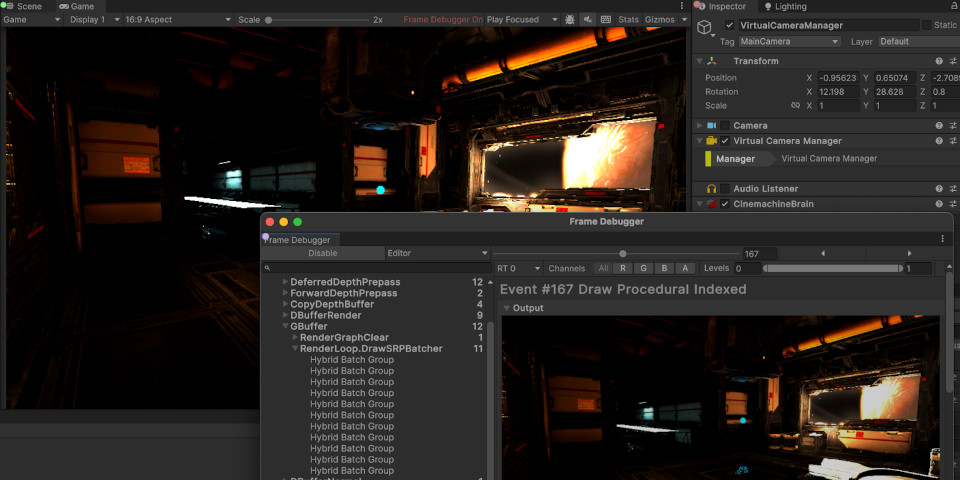Unity releases Unity 6
Unity has released Unity 6, the latest Long Term Support release of the game engine and real-time renderer.
It brings together the new features added in the previous three updates – Unity 2023.1, Unity 2023.2 and the Unity 6 Preview – in a release that will continue to receive active product support for “many years longer” than previous LTS versions.
For CG artists, key changes include better rendering of water, clouds, hair and skin, the GPU Resident Drawer for faster rendering of complex scenes, and new render upscaling tech.
Unity has also changed the price and licensing conditions for Unity subscriptions, although it has now scrapped its unpopular proposed Unity Runtime Fee.
New version numbering in Unity 6
The first thing to note about the release is that it’s Unity 6, not Unity 2023 LTS.
Unity announced last year that it intended to switch back to labelling releases according to version number rather than the year of release.
Previously, there would be two ‘tech stream’ updates that introduced new features to Unity each year, followed by a LTS release that added no new features, but which would continue to receive bugfix updates for a period of two years.
This meant that, confusingly, the year in the title of a LTS version would not be the year in which it was actually released – Unity 2022 LTS was actually released in 2023, for example – since the versioning reflected the release date of the previous tech stream updates.
New update schedule in Unity 6
Unity also now intends for follow a more conventional update schedule, with major compatibility-breaking releases like Unity 6 now followed by a series of 6.x updates.
Updates will introduce new features, but will not be compatibility-breaking, and will undergo the “rigorous regression testing of a major release”.
Unity has already previewed part of the Unity 6.x roadmap, with the first update, Unity 6.1, due in April 2025.
In addition, the firm will now provide active product support for each major release for two years after the next one ships: so Unity 6 will continue to receive fixes for critical issues for two years after Unity 7 is eventually released.
You can read more about the new release and support schedule in this blog post.
New pricing and licensing in Unity 6
However, one key change originally scheduled for Unity 6 that will not now be happening is the introduction of the Unity Runtime Fee.
The Runtime Fee – a proposed per-install fee on games created with the engine – was incredibly unpopular with Unity users, and was scrapped last month.
Unity now plans to stick with its existing subscription-only pricing model, albeit with price rises due to come into force next year.
The change is good news for users with free Personal subscriptions, which no longer insert an obligatory ‘Made With Unity’ splash screen into games created with them, and which are now available to anyone earning under $200,000/year, up from $100,000/year.
You can read more about the pricing and licensing changes to Unity 6 in this story.

Unity 6’s new GPU Resident Drawer system improves the rendering of complex scenes.
New artist features in Unity 6
But after all of that, what’s actually new in Unity 6?
Although it has a few minor new features in its own right, most of the key changes were made in the previous three releases: Unity 2023.1, Unity 2023.2 and the Unity 6 Preview.
For artists, key changes from those releases include the new GPU Resident Drawer system, which speeds up rendering of complex scenes with a lot of instanced objects.
There are also improvements to the rendering of water, clouds, hair and skin in the HDRP render pipeline, new render upscaling technologies, and better light baking workflow.
We’ve covered those new features at the time they were released, so check out our picks of the five key features for CG artists in the Unity 6 Preview and in Unity 2023.1.
Price and system requirements
The Unity 6 Editor is compatible with Windows 10+, macOS 11.0+ and Ubuntu 22.04/24.04 Linux. It is available rental-only.
Free Personal subscriptions are now available for artists and small studios earning under $200,000/year, and include all of the core features.
Pro subscriptions, for mid-sized studios, cost $2,080/year. Enterprise subscriptions, for studios with revenue over $25 million/year, are priced on demand.
Read an overview of the changes in Unity 6 on Unity’s blog
Read a full list of new features in Unity 6 in the online release notes
Have your say on this story by following CG Channel on Facebook, Instagram and X (formerly Twitter). As well as being able to comment on stories, followers of our social media accounts can see videos we don’t post on the site itself, including making-ofs for the latest VFX movies, animations, games cinematics and motion graphics projects.
